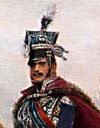 |
| Napoleon Maneuvers on Smolensk, one of his masterpiece plans |
In support of these operations, Napoleon also devised a carefully considered system of communications. He ordered that the town of Vitebsk was to be fortified and provided with a garrison of 3,000 men to protect his northern flank and serve as his center of operations in the early stages. Once the secret was out of the bag and the Russians became aware of his broad intentions, the lines of communication were to be re-channeled through Orsha, running back to Vilna by way of Borisov and Minsk.
 |
| The strategy of envelopment; schematic |
The preliminary movements began on August 11, and by the 13th the army was massed in its appointed forming up area, ready to cross the Dnieper. The Grande Armee's change of front had so far gone undetected, thanks to the excellent work of the cavalry screen and the concealment offered by the densely wooded nature of the terrain. On the night of the 13th-14th, General Eble completed the throwing of four pontoon bridges over the Dnieper near Rosasna and the crossing could begin. By dawn, n less than 175,000 troops were safely over the obstacle. The advance toward Smolensk was immediately ordered, and the corps marched off at a fast pace behind the protective screen provided by Grouchy's, Nansouty's and Montbrun's cavalry. The weather was dry, the roads were good, and by three in the afternoon, the leading elements had reached the town of Krasnoe, some 30 miles west of Smolensk, and there encountered the first sign of Russian opposition.
~ D. Chandler, The Campaigns of Napoleon, p784
























































No comments:
Post a Comment